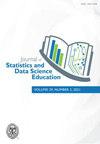IN PURSUIT OF CAMPUS-WIDE DATA LITERACY: A GUIDE TO DEVELOPING A STATISTICS COURSE FOR STUDENTS IN NON-QUANTITATIVE FIELDS
IF 1.6
Q2 EDUCATION, SCIENTIFIC DISCIPLINES
Journal of Statistics and Data Science Education
Pub Date : 2023-10-31
DOI:10.1080/26939169.2023.2276844
引用次数: 0
Abstract
Data literacy for students in non-quantitative fields is important as statistics become the grammar of research and how the world’s decisions are made. Statistics courses are typically offered by mathematics or statistics departments or by social and natural sciences such as economics, political science, psychology, and biology. Here we discuss how to construct a statistics course for students in non-quantitative fields, with a goal of integrating statistical material with students' substantive interests, using student-focused teaching methods and technology to increase student involvement. We demonstrate this kind of hybrid course with the example of an introductory applied statistics class, taught at both the University of Toronto's Anne Tanenbaum Centre for Jewish Studies and the United States Naval Academy.追求校园范围的数据素养:为非定量领域的学生开发统计课程的指南
对于非定量领域的学生来说,数据素养非常重要,因为统计已成为研究的语法和世界决策的制定方式。统计学课程通常由数学系或统计学系或社会科学和自然科学(如经济学、政治学、心理学和生物学)提供。在这里,我们讨论如何为非定量领域的学生构建统计学课程,以将统计材料与学生的实质性兴趣相结合为目标,使用以学生为中心的教学方法和技术来提高学生的参与度。我们以多伦多大学安妮·塔南鲍姆犹太研究中心和美国海军学院开设的应用统计学入门课程为例,展示了这种混合课程。
本文章由计算机程序翻译,如有差异,请以英文原文为准。
求助全文
约1分钟内获得全文
求助全文
来源期刊

Journal of Statistics and Data Science Education
EDUCATION, SCIENTIFIC DISCIPLINES-
CiteScore
3.90
自引率
35.30%
发文量
52
审稿时长
12 weeks
 求助内容:
求助内容: 应助结果提醒方式:
应助结果提醒方式:


